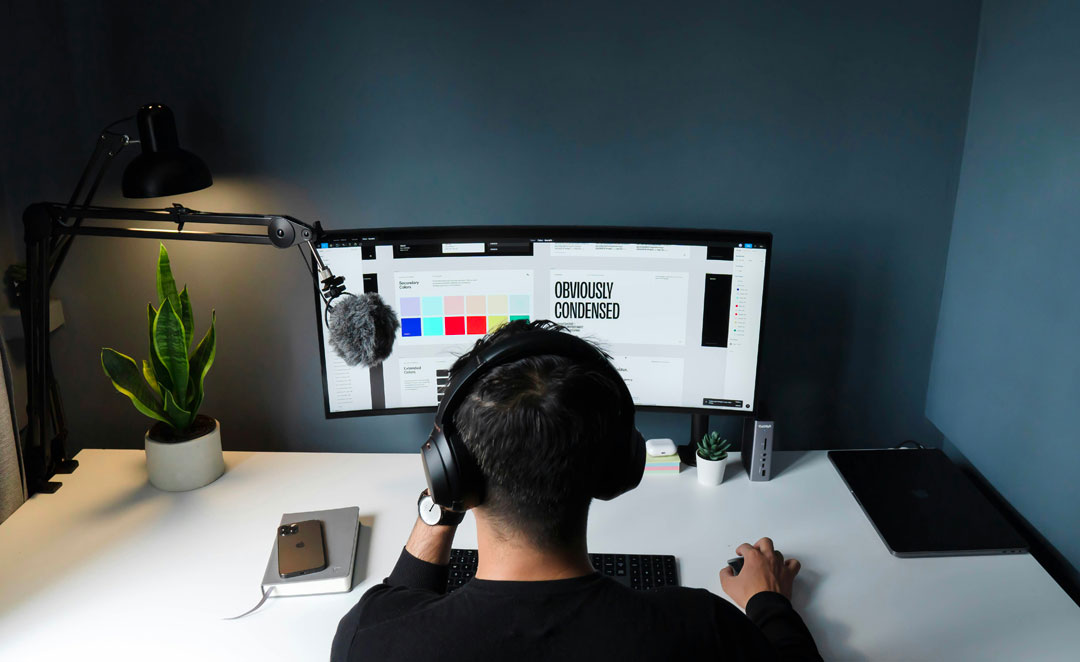Your startup's website is often the first real interaction potential customers, investors, or talent have with your company. Before anyone uses your product, reads your pitch deck, or meets your team, they're likely visiting your site—forming judgments about your professionalism, credibility, and whether you're worth their time.
Yet most startups treat startup web design as an afterthought. Founders pour energy into product development and customer acquisition while their website remains a hastily assembled placeholder that undermines everything else they've built. This approach costs opportunities daily—lost customers who bounce within seconds, investors who question execution capability, and talent who choose competitors with stronger online presence.
Effective web design for startups isn't about winning design awards or following trends. It's about building a strategic asset that communicates value clearly, builds trust systematically, and converts visitors into customers, investors, or employees. This guide explains what startup website design actually requires, common mistakes that hold companies back, and how to build sites that support growth rather than limiting it.
Why Startup Web Design Matters More Than You Think
First Impressions Are Immediate and Lasting
Research shows users form opinions about websites within 50 milliseconds. In that split second, visitors decide whether your startup looks credible, professional, and worth exploring further. Poor design creates negative bias that's difficult to overcome even with great content or products.
This isn't superficial judgment—it's efficient decision-making. When evaluating dozens of potential solutions, customers use available signals to filter quickly. Your website's design quality serves as proxy for product quality, company competence, and likelihood of success. Amateur websites suggest amateur operations.
Conversion Starts With Design
Every visitor to your site arrives with questions and concerns. Will this product solve my problem? Can I trust this company? Is this worth my time and money? Effective startup website design answers these questions systematically through strategic information architecture, clear value communication, and trust-building elements.
Conversion optimization isn't just about button colors and placement. It's about understanding visitor psychology and designing experiences that address concerns, demonstrate value, and make taking action feel safe and obvious. Professional web design for startups integrates conversion thinking from the beginning rather than treating it as afterthought.
Competitive Differentiation Through Design
In crowded markets where products reach feature parity quickly, design becomes primary differentiator. Your website can communicate sophistication, innovation, reliability, or approachability—whatever positioning you're claiming—before visitors read a single word.
Generic template websites signal that you haven't invested in presentation, which leads prospects to assume you haven't invested in product quality either. Distinctive, professional design suggests a company that cares about details and executes well.
Essential Elements of Effective Startup Websites
Clear Value Proposition Above the Fold
The most critical element of startup web design is immediate clarity about what you do and why visitors should care. Your homepage headline and subheadline should pass the five-second test—can someone unfamiliar with your company understand your value in five seconds?
Bad examples use vague language like "Transform your business with AI" or jargon-heavy descriptions like "Enterprise-grade data orchestration platform." Good examples clearly state the outcome customers achieve: "Design and ship products faster" or "Project management built for software teams."
Support your value proposition with a brief explanation and clear call-to-action. Don't bury your value proposition below fold or assume visitors will scroll to find it. Make it obvious immediately.
Strategic Information Architecture
How you organize information determines whether visitors find what they need or leave frustrated. Most startup websites make the mistake of organizing by company structure rather than customer needs.
Think about visitor intent. Potential customers want to understand your product, see pricing, and evaluate whether you're credible. Investors need company information, traction metrics, and team backgrounds. Talent wants to understand company culture and open positions. Design navigation and page structure around these actual needs.
Limit top navigation to five to seven items. Every additional option increases cognitive load and makes decisions harder. Focus on essentials: Product, Pricing, About, Resources, Contact or similar customer-centric categories.
Trust Signals and Social Proof
Startups lack the brand recognition of established companies, making trust-building through design essential. Every element should either demonstrate credibility or address concerns.
Incorporate customer testimonials with photos and company names when possible. Display logos of recognizable customers or partners. Show usage metrics that demonstrate scale. Include security certifications, compliance badges, or third-party validations relevant to your industry.
For B2B startups especially, case studies showing specific customer results provide powerful social proof. Don't hide these on separate pages—integrate them throughout your site where relevant to visitor journey.
Mobile-First Responsive Design
Over 60% of web traffic comes from mobile devices, yet many startup websites provide poor mobile experiences. Designing mobile-first forces prioritization of essential content and ensures mobile works flawlessly rather than being afterthought adaptation.
Test your website on actual phones, not just browser developer tools. Different screen sizes, older devices, and slower connections reveal problems invisible on designer laptops. Ensure buttons are large enough to tap accurately, forms are easy to complete on mobile, and load times remain fast on cellular networks.
Mobile experience directly impacts conversion. Visitors who struggle with mobile sites leave immediately. In many categories, mobile conversion rates exceed desktop because users can take action wherever they are rather than waiting until they're at computers.
Performance and Loading Speed
Website speed affects everything—search rankings, conversion rates, user experience, and perception of professionalism. Sites loading in under two seconds convert significantly better than those taking four or more seconds.
Optimize images aggressively. Use modern formats like WebP. Implement lazy loading for below-fold content. Minimize JavaScript and CSS. Enable browser caching. Use content delivery networks for faster global access.
Tools like Google PageSpeed Insights, GTmetrix, and WebPageTest identify specific performance issues. Aim for scores above 90 on mobile and desktop. Every second of load time costs conversions.
Clear Calls-to-Action
Confused visitors don't convert. Every page needs clear direction about what visitors should do next. Establish hierarchy—one primary call-to-action per page with secondary options less prominent.
Primary CTAs should use action-oriented language specific to benefit: "Start Free Trial," "Get Demo," "Calculate Savings" rather than generic "Learn More" or "Click Here." Make CTAs visually distinctive through color contrast, size, and whitespace.
Place primary CTAs in hero section above fold, after explaining key benefits, and at bottom after making full case. Don't hide important actions behind menus or bury them on separate pages.
Common Startup Website Design Mistakes
Treating Website as Brochure
Many founders view websites as static information about their company rather than dynamic tools for achieving business objectives. This leads to websites that describe what the company does without helping visitors take meaningful action.
Your website should actively work to convert visitors—capturing emails, starting trials, booking demos, whatever metrics matter for your business model. Every element should serve conversion goal or be eliminated.
Copying Competitors Without Strategy
Looking at successful companies in your space and recreating their aesthetic seems safe but creates generic websites indistinguishable from alternatives. Stripe's design works for Stripe because it reflects their specific positioning and emerged from strategic thinking, not because gradient backgrounds are inherently superior.
Build website reflecting your unique positioning and personality. Study what makes competitor sites effective strategically, then apply those principles to your specific situation rather than copying their visual solutions.
Overcomplicating Design
Some startups mistake complexity for sophistication, creating websites with elaborate animations, complex navigation, or overwhelming visual elements. This approach usually backfires—slowing load times, confusing visitors, and creating maintenance nightmares.
Simplicity works. Clean layouts with generous whitespace, clear typography, and purposeful design elements communicate confidence and professionalism better than busy, complicated approaches.
Neglecting Content Quality
Beautiful design can't save poor content. If your value proposition is unclear, your messaging confusing, or your copy generic, design won't fix fundamental communication problems.
Invest in content strategy alongside visual design. Clear, benefit-focused writing that addresses customer needs and concerns matters as much as aesthetics. Consider working with professional copywriters who understand startup messaging.
Ignoring Ongoing Optimization
Launching website isn't the end—it's the beginning of continuous improvement process. The best startup websites evolve based on user behavior, testing, and market feedback.
Set up analytics tracking visitor behavior. Run A/B tests on key elements like headlines, CTAs, and page layouts. Gather user feedback through surveys or interviews. Use tools like heatmaps to understand how visitors actually interact with your site.
Choosing the Right Approach for Your Startup
Build vs. Buy vs. Hire
Startups face three basic options: building website themselves, using templates or website builders, or hiring professional web design and development help.
DIY makes sense only if you have design expertise and time. Most founder-designed websites look amateur because design is specialized skill requiring years to develop. Time spent on website is time not spent on product or customers.
Template-based builders like Webflow, Framer, or Squarespace offer middle ground—professional-looking results without custom development. This works well for straightforward sites but can be limiting for complex needs or unique branding.
Professional design and development delivers best results but requires real investment. For most funded startups, this is optimal choice—professional presentation that positions you credibly while freeing founders to focus on business.
"Founders often underestimate how much website quality affects every other part of building a company. Professional site makes fundraising easier, customer acquisition more efficient, and talent recruitment smoother. The investment returns multiples through improved perception and conversion."— Dmitry Komissarov, Founder, Metabrand
Timeline Expectations
Quality startup web design typically requires four to eight weeks from strategy through launch. This includes research, design iterations, development, content creation, and testing.
Beware of promises for complete custom sites in one to two weeks. Either quality suffers or you're getting template with minor customization. Rushing produces suboptimal results requiring expensive fixes later.
Conversely, projects extending beyond three months usually involve excessive bureaucracy or indecision. Professional agencies with startup-optimized processes deliver comprehensive sites in reasonable timeframes.
Investment Levels
Professional startup website design typically costs between ten thousand and thirty thousand dollars depending on complexity and scope.
Budget ranges include strategy, design, development, copywriting support, and basic optimization. Lower-cost options sacrifice customization or strategic depth. Higher investments include sophisticated features, extensive content development, or complex technical requirements.
Consider this investment relative to customer acquisition costs. If professional website improves conversion by even small percentage, it pays for itself quickly through reduced acquisition costs and increased revenue.
Working With Web Design Professionals
What to Look For
When evaluating design partners, prioritize startup experience over agency size or client roster. Agencies understanding startup constraints, timelines, and business models deliver better results than those applying corporate processes to startups.
Review portfolios for relevant work. Can they show websites from companies at your stage? Do case studies explain strategic thinking or just showcase aesthetics? Request references from actual clients and ask about experience, communication, and results.
Evaluate process clarity. Good agencies explain their approach, timeline, and deliverables clearly. Vague processes or reluctance to commit to timelines suggest problems ahead.
Key Questions to Ask
Before engaging agency or freelancer, ask:
What's your typical timeline from kickoff to launch? How do you handle revisions and feedback? What exactly is included in quoted price? Who will actually work on my project? What happens after launch if issues arise? Can I see specific examples of startup websites you've designed?
Clear answers to these questions reveal whether you're talking to right partner. Hesitation, vagueness, or inability to provide specific examples are warning signs.
Maximizing the Relationship
Best results come from collaborative partnerships where both sides contribute expertise. You provide business context, market understanding, and customer insights. Design professionals provide strategic thinking, technical expertise, and execution capability.
Be responsive to requests for information and feedback. Delays on your end cascade through timeline. Provide clear, specific feedback rather than vague reactions. Trust professional expertise while ensuring final product serves your business objectives.
Conclusion: Website as Growth Infrastructure
Effective startup web design isn't expense—it's infrastructure investment enabling growth. Professional website improves every customer touchpoint, supports fundraising efforts, aids talent recruitment, and provides foundation for marketing initiatives.
The website design for startups in 2025 balances strategic clarity with visual sophistication, conversion optimization with brand expression, and immediate impact with long-term scalability. It's designed mobile-first, loads fast, communicates value instantly, and builds trust systematically.
Don't let subpar website hold back great product. Invest appropriately in professional design that positions your startup credibly and converts visitors efficiently. The returns—improved conversion, faster growth, easier fundraising—justify investment many times over.
Ready to elevate your startup's brand and website? Get a free quote from Metabrand.










